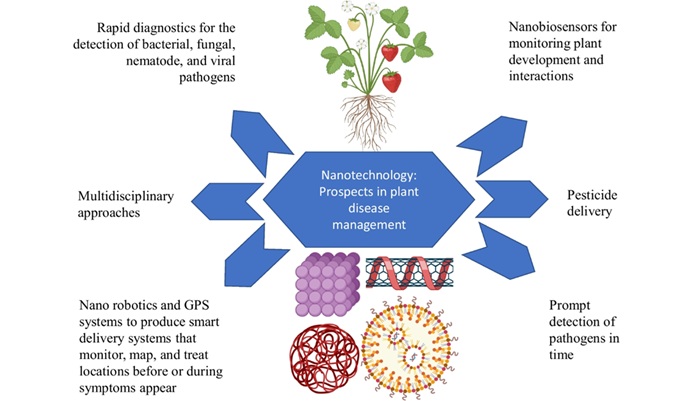A Comprehensive Review: Nanotechnology scope and application in plant disease management

DOI:
https://doi.org/10.54060/a2zjournals.jase.88Keywords:
Biosensor, Nanotechnology, Nanoparticles, PathologyAbstract
Nanotechnology has the potential for addressing current issues related to agriculture and is an innovative technique for increasing the production of crops. A wide variety of materials, such as metal, metallic oxides, nonmetals, ceramics, semiconductors, polymeric structures, lipid-based nanostructures, carbon-based nanostructures and quantum dots, are included in nanoparticles, which range in size from 1 to 100 na-nometers. Their use asherbicides, pesticides, insecticides, and nano fertilizers has been made easier by their large surface area, strong reactivity, and nanoscale size. Furthermore, nanoparticles can be engineered to function as carriers of genetic material, molecular probes, and agrichemicals as well as biosensors in the diagnosis of plant diseases. The use of nanotechnology in plant pathology has increased dramatically in the last ten years, with nanomaterials being essential for molecular tools for study, disease management, and detection. Utilizing metallic and metallic oxide nanoparticles as antibacterial agents and nano fertilizers to inhibit infections and improve plant health has received a lot of attention. Much research has also been done on their potential as sensor technology for accurate and quick diagnosis of plant diseases. The field of nanotechnology provides promising alternatives as the need for environmentally friendly agricultural methods grows globally in the face of climate change issues. Nanoparticles have the potential to completely transform agricultural disease management techniques by reducing chemical inputs and facilitating the quick identification of pathogenic organisms, hence promoting sustainable as well as resilient food systems.
Downloads
References
J. Parveen et al., “Phytosynthesized Nanoparticles as Novel Antifungal Agent for Sustainable Agriculture: A Mechanis-tic Approach, Current Advances, and Future Directions,” Journal of Nanotechnology, vol. 2023, no. 1, 2023.
G. Vanti and M. Kurjogi, “Green nanotechnology: A promising tool for agri-culture disease management,” in Advances in Nano-Fertilizers and Nano-Pesticides in Agriculture, Woodhead Publishing.
J. B. Manoj and M. L. Jones, “Natural or green synthesis nano-materials and impact on plant pathogens,” in Nanotechnology-Based Sustainable Alternatives for the Management of Plant Diseases, Elsevier.
D. L. Wasule, P. R. Shingote, and S. Saxena, “Exploitation of functionalized green nanomaterials for plant disease management,” Discov Nano, vol. 19, no. 1, p. 118, 2024.
U. Haq and S. Imran, “Use of metallic nanoparticles and nanoformulations as nanofun-gicides for sustainable disease management in plants,” Nanobiotechnology in bioformula-tions, pp. 289–316, 2019.
K. Kralova and J. Jampilek, “Applications of nanomaterials in plant disease manage-ment and protection,” in Nanotechnology in agriculture and agroecosystems, Else-vier, 2023, pp. 239–296.
D. L. Wasule, P. R. Shingote, and S. Saxena, “Exploitation of functionalized green nanomaterials for plant disease management,” Discov Nano, vol. 19, no. 1, p. 118, 2024.
P. Balashanmugam, M. D. Balakumaran, R. Murugan, K. Dhanapal, and P. T. Kalaichelvan, “Phytogenic synthesis of silver nanoparticles, optimization and evaluation of in vitro antifungal activity against human and plant patho-gens,” Microbiol. Res., vol. 192, pp. 52–64, 2016.
P. Tyagi, S. Kumar, A. Tyagi, A. Kumar, and D. Ahuja, “Contribution of nanotechnology in the fight against COVID-19,” Biointerface Res Appl Chem, vol. 11, pp. 8233–8241, 2020.
I. Akpinar, M. Unal, and T. Sar, “Potential antifungal effects of silver nanoparticles (AgNPs) of different sizes against phytopathogenic Fusarium oxysporum f. sp. radicis-lycopersici (FORL) strains,” SN Appl. Sci., vol. 3, no. 4, 2021.
A. I. Nicolaza, D. Mtz-Enriquez, G. Sánchez-Rangel, F. Carrión, and G. Para-Guay-Delgado, “Green-synthesized copper nanoparticles as a potential an-tifungal against plant pathogens,” RSC advances, vol. 9, no. 33, pp. 18835–18843, 2019.
K. S. Iliger et al., “Copper nanoparticles: Green synthesis and managing fruit rot disease of chilli caused by Colleto-trichum capsici,” Saudi J. Biol. Sci., vol. 28, no. 2, pp. 1477–1486, 2021.
R. Mahmoud, “Effect of spraying nano zinc on the growth of two cultivars of broad beans in-fected with alternari-alspote,” Euphrates journal of agricultural science, vol. 15, no. 4, pp. 116–128, 2023.
M. Imran, M. E. Abo-Elyousr, E. F. El-Sharnouby, M. A. Nashwa, and I. R. Bagy, “Biocontrol potential of Trichoderma harzianum and zinc nanoparticles to mitigate gray mold disease of toma-to,” GesundePflanzen, vol. 75, no. 1, pp. 151–163, 2023.
M. Atiq, H. M. R. Mazhar, N. A. Rajput, U. Ahmad, A. Hameed, and A. Lodhi, “Green synthesis of silver and copper nanoparticles from leaves of eucalyptus globulus and assessment of its anti-bacterial potential towards Xanthomo-nas citri pv. citri causing citrus canker,” Appl Ecol Environ Res, vol. 20, no. 3, pp. 2205–2213, 2022.
A. I. El-Batal, N. A. Eid, R. S. Al-Habeeb, W. M. Al-Bishri, G. S. El-Sayyad, and A. E. Badran, “Promising antifungal be-havior of biosynthesized bimetallic silver-copper oxide nanoparticles and Bacillus safensis against some strawberry rots,” Physiol. Mol. Plant Pathol., vol. 133, no. 102366, p. 102366, 2024.
A. Shukla, M. K. Mishra, S. K. Dwibedi, and M. Bal, “Medicinal plant-derived copper nanoparticles effectively manage early blight disease in tomato: An in vitro study,” International Journal of Environment and Climate Change, vol. 13, no. 11, pp. 2803–2814, 2023.
F. ur Rehman, N. P. Paker, S. ur Rehman, M. T. Javed, M. Farooq Hussain Munis, and H. J. Chaudhary, “Zinc oxide na-noparticles: biogenesis and applications against phytopathogens,” J. Plant Pathol., vol. 106, no. 1, pp. 45–65, 2023.
F. S. Fraga, A. C. A. Silva, N. O. Dantas, N. D. Tebaldi, and J. M. Q. Luz, “Doped zinc-oxide nanocrystals for the control of tomato bacterial spot and Xanthomonas gardneri in seeds,” Trop. Plant Pathol., vol. 46, no. 4, pp. 406–413, 2021.
H. Hameed et al., “Green synthesis of zinc oxide (ZnO) nanoparticles from green algae and their assessment in vari-ous biological applications,” Micromachines (Basel), vol. 14, no. 5, 2023.
L. Almeida et al., “Silver nano-particles as potential fungicide against rice brown spot: physiological and biochemical responses in plants,” Tropical Plant Pathology, pp. 1–13, 2024.
N. T. Elazab, A. M. Zakaria, H. Hazem, and M. M. Saleh, “Green syn-thesis of silver nanoparticles using Cakile maritima seed extract: Molecular, antifungal and physi-ological studies,” Physiological and Molecular Plant Pathology, vol. 129, 2024.
W. H. Elmer, N. Zuverza-Mena, L. R. Triplett, E. L. Roberts, R. A. Silady, and J. C. White, “Foliar application of copper oxide nanoparticles suppresses Fusarium wilt development on chrysanthemum,” Environ. Sci. Technol., vol. 55, no. 15, pp. 10805–10810, 2021.
M. Irshad et al., “Exploring the antifungal activities of green nanoparticles for sustainable agriculture: a research up-date,” Chemical and Biological Technologies in Agriculture, vol. 11, no. 1, 2024.

Downloads
Published
How to Cite
CITATION COUNT
Issue
Section
License
Copyright (c) 2025 Nisha Saini

This work is licensed under a Creative Commons Attribution 4.0 International License.



























